Introduction to Modern Drywall Design and Material Trends
In recent years, the construction and interior design industries have witnessed significant innovations, particularly in the segment of drywall design and materials. Drywall, also known as plasterboard or gypsum board, has evolved from merely an alternative to traditional lath and plaster to a forefront choice for interior walls and ceilings, offering enhanced performance, aesthetic flexibility, and environmental benefits. This article explores the latest trends in drywall design and material innovations that are shaping modern interiors.
Material Innovations in Drywall
Eco-Friendly Drywall Solutions
With a growing emphasis on sustainable construction practices, manufacturers have introduced eco-friendly drywall options. These products are made from recycled materials and are designed to be recyclable at the end of their lifecycle. Furthermore, some eco-friendly drywall solutions incorporate materials that have a lower environmental impact during their production process, such as reduced water usage and lower emissions.
Enhanced Moisture and Mold Resistance
Moisture and mold resistance has always been a concern with traditional drywall products. To address this, new drywall materials are being enhanced with fiberglass mats instead of the conventional paper facing. These fiberglass mats significantly inhibit mold growth and withstand moisture better, making them ideal for bathrooms, kitchens, and other high humidity areas.
Improved Fire Resistance
Fire safety is a critical consideration in building materials. Advances in drywall technology have led to the development of fire-resistant gypsum boards. These boards contain fibers and additives that increase their fire resistance, providing more time for emergency evacuation and potentially saving lives.
Design Trends in Drywall
Architectural Flexibility
Modern drywall solutions offer unparalleled architectural flexibility, catering to the creative whims of architects and interior designers. Curved walls, arches, and intricate shapes that were once difficult and expensive to achieve can now be easily realized with flexible drywall products. This flexibility opens up new possibilities for innovative and personalized interior designs.
High-Performance Acoustic Drywall
Acoustic comfort is a significant aspect of interior design, especially in commercial spaces and residential buildings. New high-performance acoustic drywall products are designed to significantly reduce noise transmission between rooms or units, creating quieter and more comfortable living and working environments. These products often combine high-density gypsum cores with viscoelastic polymers to dampen sound.
Integrated Technology
The integration of technology into drywall is a groundbreaking trend. Innovative drywall panels come with built-in conduits for electrical wiring and smart home technology, eliminating the need for invasive drilling post-installation. Additionally, there are developments in creating drywall that can support Wi-Fi signals, reducing the need for exposed routers and enhancing connectivity throughout the building.
Conclusion
The evolution of drywall design and material innovations represents a significant shift toward more sustainable, safe, and flexible building practices. Eco-friendly materials, enhanced resistance properties, architectural flexibility, and the integration of technology are just some of the trends shaping the future of drywall in construction and interior design. These advancements not only improve the functional aspects of buildings but also open up new avenues for creative expression and environmental responsibility.

